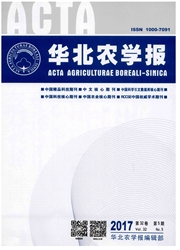

 中文摘要:
中文摘要:
通过田间试验,研究了不同施氮水平下蚕豆接种根瘤菌GS374对蚕豆/玉米间作系统氮营养的影响。结果表明,在不施氮肥的蚕豆/玉米间作系统中,与不接种相比,蚕豆接种根瘤菌GS374显著提高了系统中蚕豆、玉米的生物学产量和籽粒产量,但在N225水平下则差异不显著。在本试验的N0水平上接种根瘤菌与不接种只施用N 225kg/hm^2所获得的系统总产量相当。无论施氮与否,在蚕豆/玉米间作系统中,与蚕豆不接种相比,蚕豆接种根瘤菌对蚕豆、玉米地上部植株含氮量均无显著影响,但对整个系统的植株地上部吸氮量有显著的促进作用。换句话说,在不施氮的间作系统中,蚕豆接种处理的系统吸氮量比不接种处理提高了19.5%,在施N 225 kg/hm^2的间作系统中也提高了14.1%。同时,在不同施氮水平的蚕豆/玉米间作系统中,与蚕豆不接种处理相比,接种根瘤菌并不能显著影响0-20cm土壤的全氮、硝态氮和铵态氮含量。因此,本研究认为豆科作物接种合适的根瘤菌,是进一步提高豆科/禾本科作物间作系统氮营养间作优势的又一重要途径。
 英文摘要:
英文摘要:
A field experiment was conducted to investigate effects of inoculation of fababean with rhizobium GS374 on N nutrition in a fababean/maize intercropping system receiving nil or 225 kg/ha N. Results showed that biomass or grain yield of fababean and maize in treatment No was significantly improved by fababean inoculation rhizobium GS374 compared with the check. However, it was not so in treatment N225. Total biomass or grain yield of the fababean/maize intercropping system in treatment No where fababean was inoculated with rhizobium was similar to those in treatment N225 where fababean was not inoculated with rhizobium. In the fababean/maize intercropping system, shoot N content of fababean or maize and total N, NO3ˉ -N, NH4^+ -N content of 0 - 20 cm soil were not markedly increased by rhizobium inoculation compared with the check regardless of whether receiving nil or 225 kg/ha N, but the total shoot N uptake in the intercropping system was significantly improved by rhizobium inoculation. In other words, in treatment No and N225, the effect of inoculation on total shoot N uptake in the intercropping system was significant, increasing by 19.5 % and 14.1%, respectively. So it is held that inoculation of bean crops with appropriate rhizobium is an approach to further promoting the merits of N nutrition of the legumious/gramineous intercropping system.
 同期刊论文项目
同期刊论文项目
 同项目期刊论文
同项目期刊论文
 Root exudation of maize promoted nodulation and N2 fixation of faba bean in faba bean/maize intercro
Root exudation of maize promoted nodulation and N2 fixation of faba bean in faba bean/maize intercro Overyielding and interspecific interactions mediated by nitrogen fertilization in faba bean-, wheat-
Overyielding and interspecific interactions mediated by nitrogen fertilization in faba bean-, wheat- Effects of below-ground root barriers on nodulation and N2 fixation of faba bean intercropped with m
Effects of below-ground root barriers on nodulation and N2 fixation of faba bean intercropped with m 期刊信息
期刊信息
